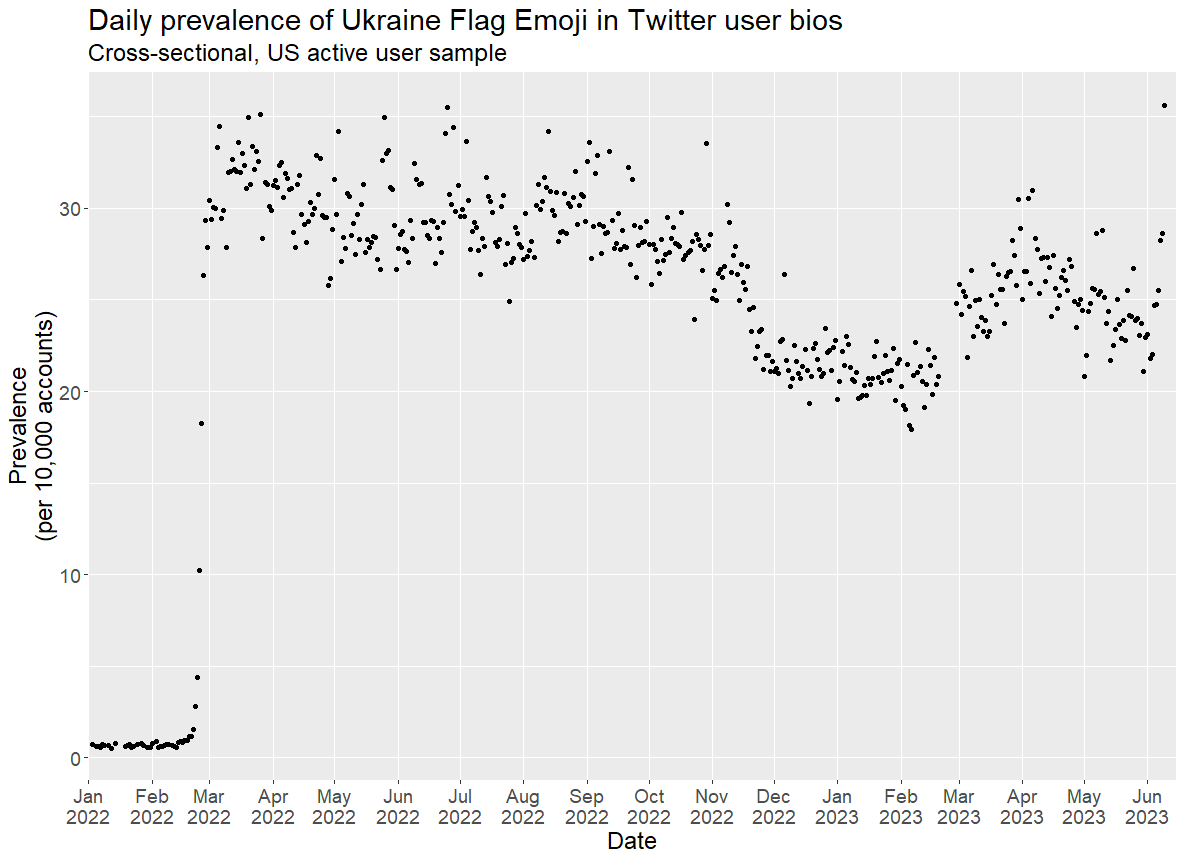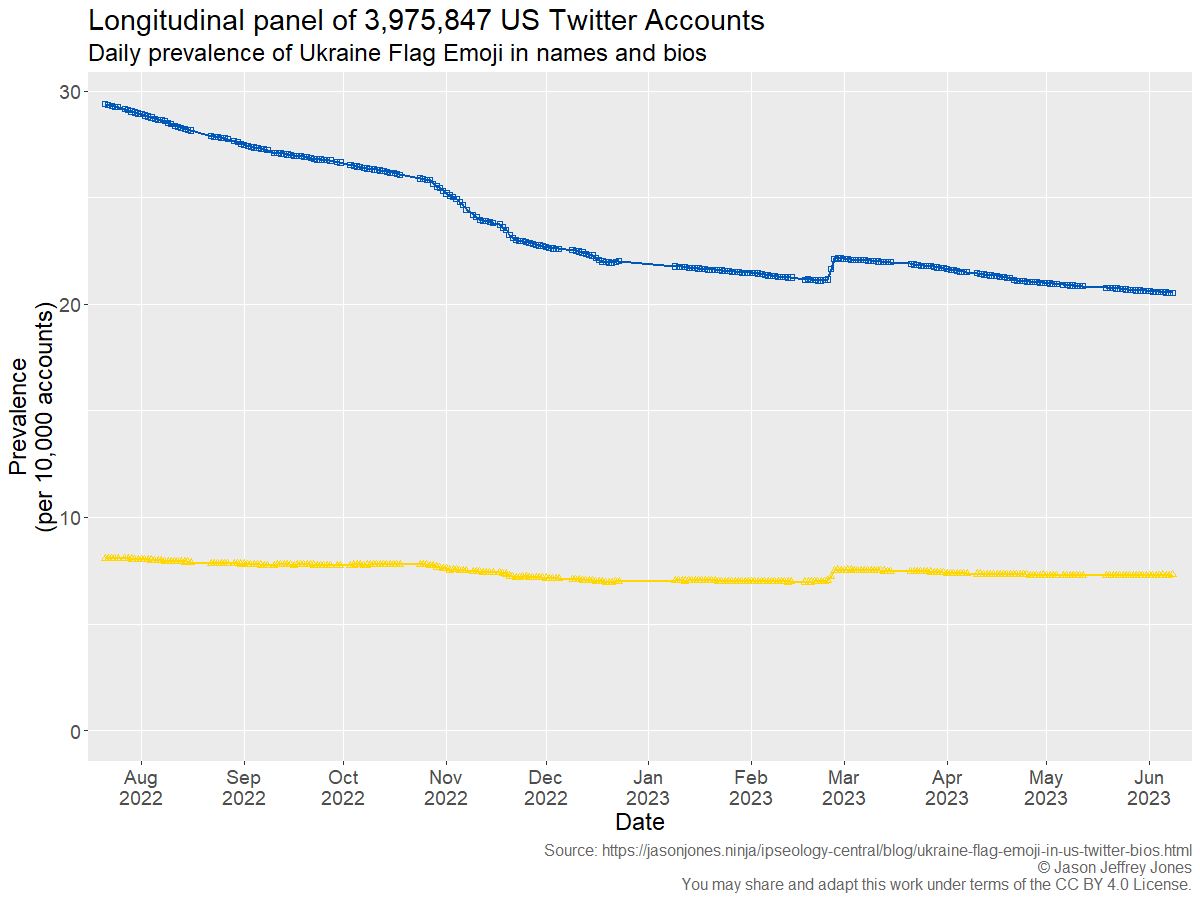Ipseology
using large datasets
and computational methods
Ukraine Flag Emoji 🇺🇦 Prevalence in US Users' Twitter Bios
Do Americans still show support for Ukraine?
2023-06-23
Let's examine one way to answer the question Do Americans still show support for Ukraine?. Specifically, we'll track the prevalence of active US Twitter users with the Ukraine flag emoji in their profile bio. We'll estimate this at daily resolution by using a 1% random sample of all posted tweets.
Background
About a year ago, a student and I began measuring identity activism in support of Ukraine. We found explosive growth initially, followed by slow decay. Read all the details in this open-access, peer-reviewed research article.
The war has continued. Availability of Twitter data has not. However, through June 8, 2023, we can apply our same methods:
- Observe a random 1% sample of all tweets.
- Filter to authors with US locations.
- Per day, limit to one tweet per unique US author. (For users who show up more than once per day, just choose one at random.)
- Extract the profile bio from the User object embedded in the posted tweet.
- Calculate how many US tweet authors per 10,000 had a Ukraine flag emoji in their bio on each day.
Let's see how 🇺🇦 display has changed over time.

Two points jump out of the series. First, obviously, is the beginning of the Russian invasion in February 2022. Notable also is the nadir just before the one year anniversary in February 2023. In tweeting US users, the Ukraine flag emoji went from nearly completely absent to a peak prevalence of 35. That would place it in the 99th percentile of all tokens! (In other words, 🇺🇦 was present in more bios than 99% of all other words, emojis, hashtags, etc.)
After the initial spike, prevalence waned. Remember that this series is cross-sectional. Each day's data comes only from those US users tweeting on that day. Therefore, declining prevalence could have many causes. It could be that active users deleted the emoji from their bio. Or it could be that the subpopulation of US Twitter that did adopt a Ukraine emoji was unusually active at the beginning of the conflict and then receded back to lower levels of activity. It could even be that newly active users were especially unlikely to include a Ukraine flag in their bio.
We'll never know, right? NO!!! We can look for the signature of each of those potential causes in the data. Because the data was collected consistently, persistently and in volume, decomposing the contributions of each cause is possible. If that sounds like something you'd like to do, join my Computational Social Science of Emerging Realities Group at Stony Brook University.
Edit 2023-06-27
Alright, due to overwhelming demand (someone asked), I'll push the analysis one step further. For a subset of US users, I have daily observations of bios July 21, 2022 through June 8, 2023. Call these nearly four million users the US Daily Longitudinal subset. They did not tweet every day. Instead, an automated script checked their profile page every day. Plotted below is the prevalence of users with 🇺🇦 in their name (blue squares and line, top) or 🇺🇦 in their bio (yellow triangles and line, lower).

In this data, if prevalence decreases, the only explanation is that more users removed 🇺🇦 than added 🇺🇦. Strictly speaking, it also may be the case that more users with 🇺🇦 deleted their entire bio or deleted their account entirely than users without it. I'm happy lumping all of these together. Over time, fewer users displayed the Ukraine flag emoji within their names and bios. Specifically, name prevalence saw a 30% decline (29.4➡️20.5) and bio prevalence a 10% decline (8.1➡️7.3).
There was a rebound corresponding to the one-year anniversary of the beginning of the conflict - just like in the cross-sectional results. In late February enough users added (or restored) 🇺🇦 to their profile that the downward trend briefly reversed.
For those wondering, these panel data began on July 21, 2022 because that was the day this particular script began running. The data ended on June 9, 2023 because that was day Elon finally came for my API keys. No more free Twitter data, so computational social science is over, right? NO!!! We're not even out of the Twitter game. Versions of the longitudinal scripts will be back in operation soon. Regardless of anything that happens in the future, we have a decade-plus of global self-representations from millions of individuals at any spatial or temporal resolution you care to calculate.
The past decade will soon become the best-understood period regarding human identity by about a million miles. And the future? As long as people like to talk about themselves online and talented people join CSSERG, we'll be golden.
Ipseology - Read and explore more
- Search for trends on any set of words: Jason Jeffrey Jones Identity Trends V2
- Quickly get familiar with ipseology terminology: Ipseology Glossary
- Read a peer-reviewed, open-access research article about the methods: A dataset for the study of identity at scale: Annual Prevalence of American Twitter Users with specified Token in their Profile Bio 2015–2020
- Read a blog post about Black Lives Matter signifiers: Estimation of Black Lives Matter prevalence in US users' Twitter bios at daily resolution.